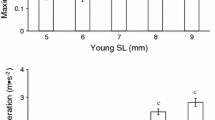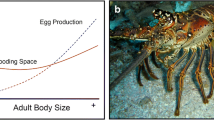Abstract
Parental care in fishes is a three-way interaction among brood predators, parental brood defence, and the escaping ability of the developing young. Convict cichlids are Neotropical freshwater fish with prolonged biparental brood defence of their eggs and free-swimming larvae. In a previous study, developmental timing of changes in larval swimming performance was correlated with larval skeletal ossification and biparental brood defence in convict cichlids in the Río Cabuyo, a stream in Costa Rica (Wisenden et al. 2015). Here, we repeat this study on a population of convict cichlids from Laguna de Xiloá, a volcanic crater lake in Nicaragua. We found that fish from Laguna de Xiloá also showed correlations among swimming performance and skeletal ossification of the larvae, and brood defence by the parents. However, in Laguna de Xiloá the developmental timing of these events was delayed relative to the Río Cabuyo population. The population difference between Costa Rica and Nicaragua could be an effect of genetic divergence or an artefact of phenotypic plasticity between lab-reared fish (Costa Rica) versus wild-caught fish (Nicaragua) for ossification scores. To resolve this question we repeated study using lab-reared fish of brood stock from Laguna de Xiloá. Comparing among the lab-reared Costa Rican fish, and lab-reared and field-collected Nicaraguan fish, we found that the timing of ossification was significantly delayed for both Nicaraguan samples relative to the Costa Rican samples. These shifts likely reflect population differences in selection on anti-predator competence of the young and, consequently, parental brood defence. These data indicate that larval ontogenetic development, anti-predator performance and parental care co-evolve with site-specific ecological differences.



Similar content being viewed by others
References
Alonzo JJ, McKaye KR, van den Berghe E (2001) Parental defence of young by the convict cichlid, Archocentrus nigrofasciatus, in Lake Xiloá, Nicaragua. J Aquaricult Aq Sci 9:208–228
Anderson MJ (2001) A new method for non-parametric multivariate analysis of variance. Austral Ecology 26:32–46
Anderson MJ (2006) Distance-based tests for homogeneity of multivariate dispersions. Biometrics 62:245–253
Arendt JD, Wilson DS (2000) Population differences in the onset of cranial ossification in pumpkinseed (Lepomis gibbosus), a potential cost of rapid growth. Can J Fish Aq Sci 57:351–356
Arnold SJ (1983) Morphology, performance and fitness. Am Zool 23:347–361
Barluenga M, Stölting KN, Salzburger W, Muschick M, Meyer A (2006) Sympatric speciation in Nicaraguan crater lake cichlid fish. Nature 439:719–723
Bassar RD, Ferriere R, López-Sepulcre A, Marshall MC, Travis J, Pringle CM, Reznick DN (2012) Direct and indirect ecosystem effects of evolutionary adaptation in the Trinidadian guppy (Poecilia reticulata). Am Nat 180:167–185
Billerbeck JM, Lankford LE, Conover DO (2001) Evolution of intrinsic growth and energy acquisition rates. I. trade-offs with swimming performance in Menidia menidia. Evolution 55:1863–1872
Bussing WA (2002) Peces de las aguas continentals de Costa Rica. Editorial de la Universidad de Costa Rica, San Jose
Dufrene M, Legendre P (1997) Species assemblages and indicator species: the need for a flexible asymmetrical approach. Ecol Monogr 61:53–73
Elmer KR, Fan S, Gunter HM, Jones JC, Boekhoff S, Kuraku S, Meyer A (2010) Rapid evolution and selection inferred from the transcriptomes of crater lake cichlid fishes. Mol Ecol 19(suppl. 1):197–211
Elmer KR, Lehtonen TK, Fan S, Meyer A (2013) Crater lake colonization by neotropical cichlids fishes. Evolution 67:281–288
Fuiman LA (1994) The interplay of ontogeny and scaling in the interactions of fish larvae and their predators. J Fish Biol 45:55–79
Fuiman LA, Magurran AE (1994) Development of predator defences in fishes. Rev Fish Biol Fish 4:145–183
Fuiman LA, Webb PW (1988) Ontogeny of routine activity and performance in zebra danios (teleostei: cyprinidae). Anim Behav 36:250–261
Fuiman LA, Rose KA, Cowan JH, Smith EP (2006) Survival skills required for predator evasion by fish larvae and their relation to laboratory measures of performance. Anim Behav 71:1389–1399
Gunter HM, Fan S, Xiong F, Franchini P, Fruciano C, Meyer A (2013) Shaping development through mechanical strain: the transcriptional basis of diet-induced phenotypic plasticity in a cichlid fish. Mol Ecol 22:4516–4513
Hale ME (1999) Locomotor mechanics during early life history: effects of size and ontogeny on fast-start performance of salmonid fishes. J Exper Biol 202:1465–1479
Itzkowitz M, Santangelo N, Richter M (2001) Parental division of labour and the shift from minimal to maximal role specialization: an experiment using a biparental fish. Anim Behav 61:1237–1245
Kautt AF, Elmer KR, Meyer A (2012) Genomic signatures of divergent selection and speciation patterns in a ‘natural experiment’, the young parallel radiations of Nicaraguan crater lake cichlid fishes. Mol Ecol 21:4770–4786
Kerschbaumer M, Postl L, Koch M, Wiedl T, Sturmbauer C (2011) Morphological distinctions despite large-scale phenotypic plasticity – analysis of wild and pond-bred juveniles of allopatric populations of Tropheus moorii. Naturwissenschaften 98:125–134
Kingsolver JG, Huey RB (2003) Introduction: the evolution of morphology, performance and fitness. Integr Comp Biol 43:361–366
Levene H (1960) Robust tests for equality of variances. Contributions to Probability and Statistics: Essays in Honor of Harold Hotelling 2:278–292
McHenry MJ, Lauder GV (2006) Ontogeny of form and function: locomotory morphology and drag in zebrafish (Danio rerio). J Morphol 267:1099–1109
McKaye KR (1977) Competition for breeding sites between the cichlid fishes of Lake Jiloá, Nicaragua. Ecology 58:291–302
Meyer A (1987) Phenotypic plasticity and heterochrony in Cichlasoma managuense (Pisces, Cichlidae) and their implications for speciation in cichlid fishes. Evolution 41:1357–1369
Podani J (1999) Extending Gower’s general coefficient of similarity for ordinal characters. Taxon 48:331–340
Post DM, Palkovacs EP (2009) Eco-evolutionary feedbacks in community and ecosystem ecology: interactions between the ecological theatre and the evolutionary play. Phil Trans R Soc B 364:1629–1640
Schmitter-Soto JJ (2007) A systematic revision of the genus Archocentrus (perciformes: cichlidae), with the description of two new genera and six new species. Zootaxa 1603:1–76
Siegel S, Castellan NJ Jr (1988) Nonparametric statistics for the behavioral sciences, 2nd edn. McGraw-Hill, New York
Solem Ø, Berg OK, Kjøsnes AJ (2006) Inter- and intra-population morphological differences between wild and farmed Atlantic salmon juveniles. J Fish Biol 69:1466–1481
Song J, Parenti LR (1995) Clearing and staining whole fish specimens for simultaneous demonstration of bone, cartilage, and nerves. Copeia 1995:114–118
Stauffer JR Jr, McKaye KR (2002) Descriptions of three new species of cichlid fishes (Teleostei: Cichlidae) from Lake Xiloá, Nicaragua. Cuad Investig UCA 12:1–18
Wisenden BD (1994) Factors affecting reproductive success of convict cichlids in costa Rican streams. Can J Zool 72:2177–2185
Wisenden BD (1995) Reproductive behaviour in free-ranging convict cichlids. Environ Biol Fish 43:121–134
Wisenden BD, Keenleyside MHA (1992) Intraspecific brood adoption in convict cichlids: a mutual benefit. Behav Ecol Sociobiol 31:263–269
Wisenden BD, Keenleyside MHA (1994) The dilution effect and differential predation following brood adoption in free-ranging convict cichlids (Cichlasoma nigrofasciatum). Ethology 96:203–212
Wisenden BD, Keenleyside MHA (1995) Brood size and the economy of brood defence: testing Lack’s hypothesis in a biparental cichlid fish. Environ Biol Fish 43:145–151
Wisenden BD, Stumbo AD, Self PA, Snekser JL, Wisenden PA, Keenleyside MHA, McEwen DC, Itzkowitz M, Brisch E (2015) Co-evolution of offspring anti-predator competence and parental brood defence in convict cichlids. Hydrobiologia 748:259–272
Acknowledgments
Field data in Costa Rica were collected under MINAE Pasaporte de Investigaciónes number 00058. Special thanks to Celso Alvarado and Henry Ramirez of the Ministerio del Ambiente y Energía, Sistema Nacional de Áreas de Conservación Arenal Tempisque (ACT MINAE). We are very grateful to Ken R McKaye and Glenn Campbell (The Scuba Shack, San Juan del Sur, Nicaragua) for their generous donation of time and in-kind equipment, lodging and staff, without which our efforts at Laguna de Xiloá would not have been possible. Ossification and startle responses were enabled by research grants from the College of Social and Natural Sciences, MSUM to Brian Wisenden, and the Dille Fund for Excellence (MSUM) to Brian Wisenden and Ellen Brisch. Anusha Mishra, Bree Hamann and Joe Mullins were critical to the early development of the methods used in the final version of the study linking skeletal ossification to escape responses.
Author information
Authors and Affiliations
Corresponding author
Ethics declarations
All applicable international, national, and/or institutional guidelines for the care and use of animals were followed. This work was conducted under protocol 07-R/T-BIO-018-N-N-C of the Minnesota State University Moorhead Institutional Animal Care and Use Committee.
Conflict of interest
The authors declare that they have no conflicts of interest.
Rights and permissions
About this article
Cite this article
Wisenden, B.D., Stumbo, A.D., McEwen, D.C. et al. Population-specific co-evolution of offspring anti-predator competence and parental brood defence in Nicaraguan convict cichlids. Environ Biol Fish 99, 325–333 (2016). https://doi.org/10.1007/s10641-016-0476-y
Received:
Accepted:
Published:
Issue Date:
DOI: https://doi.org/10.1007/s10641-016-0476-y




